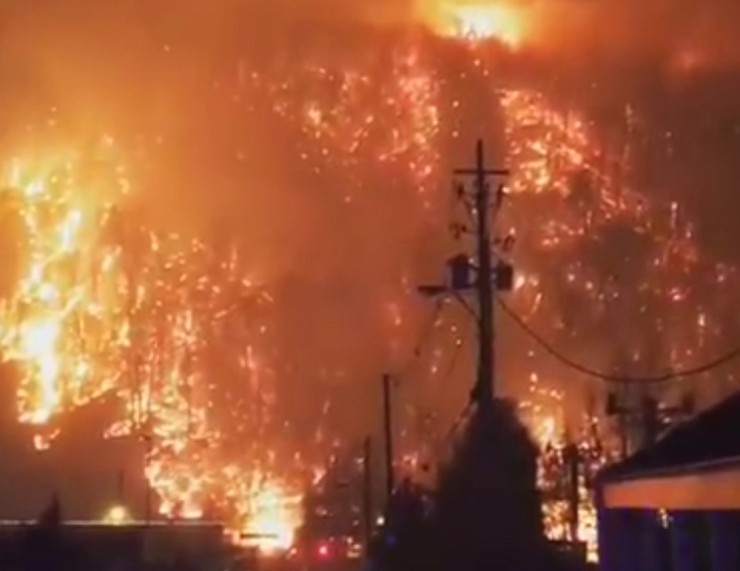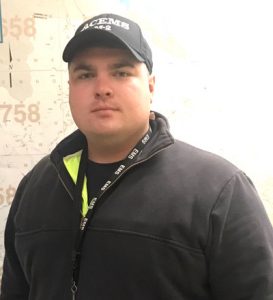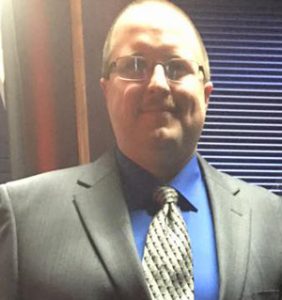
The Andersonville Volunteer Fire Department helped rescue two people trapped in an elevator in a burning building at Westgate Smoky Mountain Resort, pictured above, in Gatlinburg during the wildfires on Monday, Nov. 28, 2016. (Photo via Roane State Community College)
Editor’s note: Many fire departments and emergency workers responded to help fight the wildfires and perform search and rescue during the deadly forest fires that burned areas around Gatlinburg and Pigeon Forge on Monday, November 28. Here are stories from two Anderson County rescuers who responded to the Gatlinburg fires, as reported by Roane State Community College.
‘We made our way through what looked like the gates of hell’
By Matthew R. Burrell
On the night of Monday, November 28, various Anderson County fire departments were asked to respond on mutual aid calls to the City of Gatlinburg. Of those departments, Andersonville responded with a crew of three and one pumper.
Once we arrived at the meeting point, we were sent to Pittman Center for staging. On our way to our assigned location, there were many thoughts of the unknown. We were bouncing several scenarios off of each other—from “what are we going to do to pass time if all we do is sit in the parking lot,” to how crazy it could possibly be and what we might encounter.
When we first responded, I made contact with the Gatlinburg Fire Department chief, and the intensity in his voice told me that it was bad. But once we hit the spur, we realized just how bad it was. We made our way through what looked like the gates of hell and then entered the city. There was a constant orange glow everywhere you looked. We were amazed at the devastation and at how many buildings were on fire.
Command was sending a task force to Westgate Smoky Mountain Resort building 4000 with two occupants reported trapped in the elevator with the building on fire. As we were responding, we caught up with other responding units and all arrived on the scene at the same time. We pulled up to a building on fire, and a tower of condos behind us.
A GFD member at the elevator was calling for forcible entry tools. Firefighter Lonnie Poore and Captain James May of the Andersonville Volunteer Fire Department were told of the people trapped in the elevator, and the firefighters were at the truck ready to go. Poore was equipped with an air pack, and he had tools in his hands. He and Firefighter Austin Vick from Gatlinburg Fire Department were sent to the third floor, where they were able to force open the elevator shaft door. They found the elevator car stuck between the third and fourth floors.
They were able to assist a male out of the car and assist him to other firefighters in the stairwell to get him out.
They returned to the elevator car, where they retrieved the female occupant. Poore had to actually hop up in the car to assist her out to the landing. She was exhausted and had to be carried down and out of the stairwell from the third floor by Poore, May, and GFD personnel.
Once all occupants and fire personnel were out of the building, we resumed our defensive plan and protected both of the unburned buildings until it was time to go home.
It was remarkable to see how firefighters and emergency personnel from all over the region and country came together and worked as a team, trusting one another on the fly while putting themselves in harm’s way for the greater good.
I couldn’t be more honored to know such selfless people. The amazing part is actions like these weren’t just at Westgate, but all over Gatlinburg during this tragic event. At the end of the day whether we’re fire, EMS (emergency medical services), or law enforcement we’re all here to serve the people of our communities. In this case, it was the people of Gatlinburg and all the citizens involved.
Matthew R. Burrell is Andersonville Volunteer Fire Department Chief/EMTP in Anderson County.
Note: This story originally appeared on the Roane State Community College website. (Burrell is a Roane State Class of 2014 paramedic, and Poore completed an AEMT course at Roane State.) This story has been lightly edited here.

A picture from the Gatlinburg wildfires on Monday, Nov. 28, 2016. (Photo via Roane State Community College)
‘We saw the tired, worn souls that refused to give up’
By Matthew Wilson
Going up to assist with the relief efforts in Gatlinburg was an honor to me. I manned an ambulance for two days. Day one was spent at LeConte Medical Center. We were the primary ventilator transport unit. We were used for this for one transport.
The rest of this day, we spent time assisting in the emergency room as needed and with the shuffle outside with command. The second day, we started at LeConte waiting our turn to report to the Mountain Command. Once we did, this my world changed.
This was a very humbling experience. We interacted with several other departments that had been working hard for several days. We saw the tired, worn souls that refused to give up. We also interacted with several people at the shelter as well. We saw people still in such good spirits and coming together with one another, yet we saw they had lost pretty much everything as well.
One gentleman I spoke with on the way up to the shelter from LeConte said his main concern was knowing if his fiancé was still okay. He said, “You never know how much something so simple means until you can’t reach out and touch it for a day.”
Hearing this and seeing the togetherness and love surrounding this entire event, both inside and outside the event, has been very humbling and eye-opening for me all around.
Matthew Wilson is Anderson County Vent Paramedic.
Note: This story originally appeared on the Roane State Community College website. (Wilson is Roane State Paramedic Class of 2006-2007.) This story has been lightly edited here.


Leave a Reply